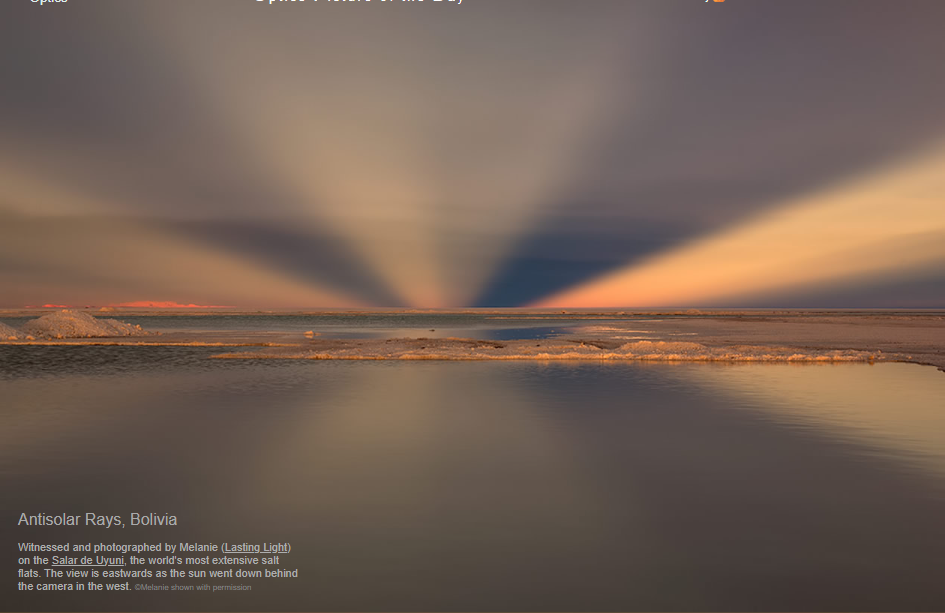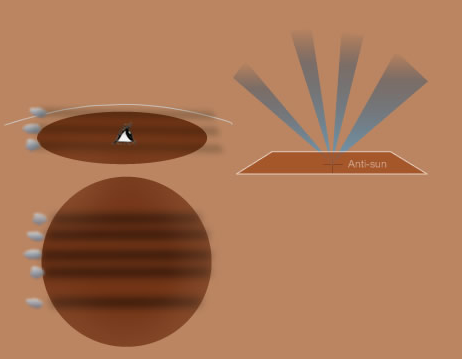Bolivia Antisolar (anticrepuscular) rays - OPOD
Bolivia Antisolar (Anticrepuscular) Rays: A Spectacular Atmospheric Phenomenon
Bolivia is home to a mesmerizing natural wonder - the Salar de Uyuni, the world's largest salt flats. Amidst this vast expanse, something truly magical occurs during sunset and sunrise - the appearance of Bolivia Antisolar Rays. These rays, also known as anticrepuscular rays, captivate observers with their ethereal beauty and enigmatic nature. Let's delve deeper into this fascinating atmospheric optics phenomenon.
The Magnificent Display of Antisolar Rays
Antisolar rays, despite their name, have no intention of banning twilight or the crepusculum. In fact, they can be observed at any time of day, although they are most spectacular during the moments near sunset and sunrise. These rays are not physical entities but rather an optical illusion created by the interplay of light and shadow in the sky.
Unveiling the Illusion
To understand the mechanism behind antisolar rays, we must examine the interplay between sunlight and clouds. As sunlight streams through gaps in the clouds, it casts shadows on the air molecules in its path. These shadows manifest as parallel tubes of unlit air, which appear to converge towards a point opposite the position of the sun. This convergence creates the illusion of rays stretching across the sky.
Shadows as Corridors of Air
As we observe the antisolar rays, an intriguing phenomenon unfolds before our eyes. The shadows gradually darken as they approach the antisolar point. This darkening occurs because our eyes are not merely looking across the shadowed air, but rather along the long corridors of shadowed air. This change in perspective intensifies the contrast and enhances the visual impact of these extraordinary rays.
The Allure of Salar de Uyuni
Bolivia's Salar de Uyuni provides a truly captivating backdrop for witnessing and photographing the beauty of antisolar rays. As the sun sets behind the camera in the west, the expansive salt flats stretch out towards the east, offering an unobstructed view of the sky. This pristine natural environment, coupled with the awe-inspiring spectacle of the rays, creates a surreal experience that leaves visitors spellbound.
Exploring Antisolar Rays Beyond Bolivia
While Bolivia's Salar de Uyuni is renowned for its stunning display of antisolar rays, this atmospheric phenomenon can be observed in various locations worldwide. Whether you find yourself on a mountaintop, by the seashore, or even in a bustling city, keep an eye on the sky during twilight hours. You may be fortunate enough to witness these rays stretching across the heavens, casting their enchanting spell upon all who gaze upon them.
The Science Behind Antisolar Rays
The formation of antisolar rays can be attributed to the principles of perspective and light scattering. When sunlight interacts with particles in the atmosphere, it scatters in all directions. This scattering phenomenon causes the sky to appear bright. However, when clouds obstruct the direct path of sunlight, shadows are cast onto the air molecules. These shadows create the illusion of converging rays opposite the sun's position.
Similarities with Other Optical Phenomena
Antisolar rays bear a resemblance to other atmospheric optics phenomena, such as crepuscular rays and railroad track convergence. Crepuscular rays, often observed during sunrise or sunset, are beams of sunlight that appear to radiate from the position of the sun. Railroad track convergence occurs when parallel tracks appear to meet in the distance due to perspective. These phenomena serve as reminders of the wonders that await those who gaze at the ever-changing sky.
Capturing Antisolar Rays: Photography Tips
For photography enthusiasts seeking to immortalize the splendor of antisolar rays, a few tips can enhance the chances of capturing this elusive phenomenon. Consider these suggestions:
- Choose a location with an unobstructed view of the sky, preferably a high vantage point or a wide-open space.
- Opt for a wide-angle lens to capture the full expanse of the sky and emphasize the convergence of the rays.
- Experiment with different exposure settings to capture the subtle variations in light and shadow.
- Consider incorporating elements of the surrounding landscape to add depth and context to your photographs.
- Be patient and observant, as the appearance of antisolar rays can be fleeting. Stay alert to seize the perfect moment.
A Reminder of Nature's Wonders
Bolivia Antisolar Rays serve as a captivating reminder of the intricate beauty and complexity of our natural world. These ethereal rays, stretching across the sky, evoke a sense of wonder and awe. Whether observed in Bolivia's Salar de Uyuni or elsewhere around the globe, these atmospheric phenomena invite us to pause, look up, and appreciate the ever-changing canvas that is our sky. Let us embrace the mysteries that unfold above us and marvel at the enchanting dance of light and shadow in the heavens.

Antisolar Rays, Bolivia
Witnessed and photographed by Melanie (Lasting Light) on the Salar de Uyuni, the world's most extensive salt flats. The view is eastwards as the sun went down behind the camera in the west. ©Melanie shown with permission

Usually called anticrepuscular rays but antisolar is more descriptive. They are not part of a lobby group to ban twilight or the crepusculum and they can even be seen at midday.
But near sunset and sunrise is when they are their most spectacular.
The 'rays' are simply the ordinary bright sky.
The shadows, cast by sunwards clouds, are parallel tubes of unlit air and only appear by perspective to converge towards the point directly opposite the sun. Roads and railway tracks similarly seem to converge in the distance.
Look at how the shadows darken as they near the antisolar point. The eye looks increasingly along the long corridors of shadowed air rather than across them.
Note: this article has been automatically converted from the old site and may not appear as intended. You can find the original article here.
Reference Atmospheric Optics
If you use any of the definitions, information, or data presented on Atmospheric Optics, please copy the link or reference below to properly credit us as the reference source. Thank you!
-
<a href="https://atoptics.co.uk/blog/bolivia-antisolar-anticrepuscular-rays-opod/">Bolivia Antisolar (anticrepuscular) rays - OPOD</a>
-
"Bolivia Antisolar (anticrepuscular) rays - OPOD". Atmospheric Optics. Accessed on November 26, 2024. https://atoptics.co.uk/blog/bolivia-antisolar-anticrepuscular-rays-opod/.
-
"Bolivia Antisolar (anticrepuscular) rays - OPOD". Atmospheric Optics, https://atoptics.co.uk/blog/bolivia-antisolar-anticrepuscular-rays-opod/. Accessed 26 November, 2024
-
Bolivia Antisolar (anticrepuscular) rays - OPOD. Atmospheric Optics. Retrieved from https://atoptics.co.uk/blog/bolivia-antisolar-anticrepuscular-rays-opod/.